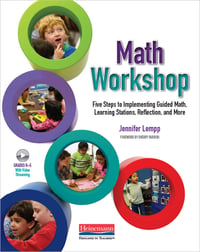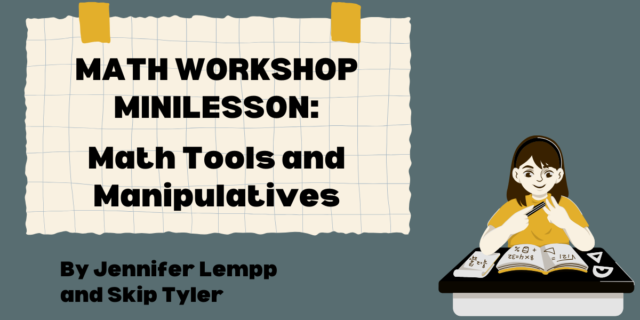
One of the greatest benefits of using a workshop approach toward the teaching of mathematics is the consistent ability for a teacher to meet students where they are. But what does that mean?
Meeting students where they are requires that we know where they are. But how can we truly know where a student is? After all, some students have learned to hide in the classroom; they avoid participating and disengage from the lessons. Others may have learned that if they smile and nod their head, a teacher may think they are actively listening and may even falsely believe that they have a strong understanding of the content.
Knowing where a student is includes several layers and is an ongoing process. Just as we continuously learn new things about our friends and family members, with time, we can get to know our students more deeply. Knowing them goes beyond recognizing whether they can get a correct answer on a problem or not. It might also include knowing:
- The strategies a student is most comfortable and least comfortable with using.
- The student’s disposition toward mathematics. Do they feel confident or does math induce anxiety?
- What they are interested in outside of school. If we want to include real world examples, then knowing about the student’s experiences and interests is important for this connection to be made.
When we know students better, we are better able to support them. We are more easily able to adjust our instruction that will best meet their needs. So, how do we know what a student already knows and what they don’t know yet? A few steps help make this possible.

- Stay Curious
We are so fortunate to have the opportunity to learn about our students, and one way we can do that is to be curious about all that they say and do. When a student explains their thinking, it may be faster and easier to restate it with more concise language. And, let’s face it, we know it can be faster if we just show them the way to solve the problem. However, doing so robs the student of the learning, and it robs us of the opportunity to learn about the student and their thought process. Being curious about a student also sends the message that you are interested in them, establishing an important student-teacher relationship. - Stay Quiet
The person doing the math and the person talking about the math is the person learning the math. Therefore, if the teacher is the one talking, we are learning very little about what a student knows. Staying quiet gives students the opportunity to think, and therefore to learn. Without interjecting our methods or processes onto students, we find out more about what students are thinking. Filling the class minutes with the teacher talking through steps leaves less time for students to talk, and there is considerable research on the impact of academic discourse on student achievement. Staying quiet is our best chance to listen to and learn more about our students. - Ask Questions
The fact is that we can’t stay quiet the whole class time. So, when it’s time to talk, choose to ask questions rather than telling or showing. It can be easy to make assumptions about a student’s thought process based on the work we see. However, rather than assuming we know, we can learn so much more by asking questions. When we see a student drawing a picture to solve a fraction problem, rather than saying, “I see you drew a picture of 2 brownies and cut them into fourths”, we can ask questions: “What do the two rectangles represent? Tell me about the lines you drew. How many pieces do you have now that you drew those lines? Does this change the amount of brownie you have?” Asking questions helps a student to become clearer about their thinking and can help us learn more about their thought process. - Refrain From Deficit Thinking
As we begin to find out more about a student, it can be tempting to label students as those who already know a concept and those who don’t. For example, you might hear “These kids do not know their multiplication facts”. Learning is so much more complex than that. If we stay curious and quiet and ask lots of great questions, we will know more than whether a student can multiply or not. In fact, you might know which multiplication problems students know quickly, those that they have a strategy to solve, those that give them more pause. We don’t want to only describe what a student cannot do when we think or talk about a student; rather, let’s consider what they do know. What are they close to? What strategies are they familiar with already? It’s a more positive way to think about anyone, and the impact it will make in our classrooms is significant. - Use Small Group Instruction
Creating lesson plans is not easy, especially when one lesson plan is supposed to impact 20 or more students at the same time. When we are teaching a whole group of students, our time to listen to students and watch them solve problems is limited. We can try to walk around the classroom as students are solving problems, but often we are left with seeing only their finished work, which does not reveal much about their thinking. Small group instruction provides us with the opportunity to learn so much about our students and support them with exactly what they need.
By staying curious and quiet, asking questions, refraining from deficit thinking, and using small group instruction, we can make the space in our classrooms where we can learn more about students and make the most of our time together.
***
Jennifer recently stopped by the Heinemann podcast with educator Kristen Stump to discuss Building Student Math Identities with the Workshop Model.

Jennifer Lempp is the author of Math Workshop: Five Steps to Implementing Guided Math, Learning Stations, Reflection, and More. This book is a practical resource meant to support teachers with strategies and structures to help create a learning environment where students are engaged in purposeful mathematics experiences.
Jennifer consults with schools and districts around the country, providing professional development on mathematics content and instructional practices. Additionally, Jennifer supports school leaders on the development of mathematics professional learning and school improvement plans.
Jennifer Lempp and Skip Tyler are hosting a free event for their book release in November.


